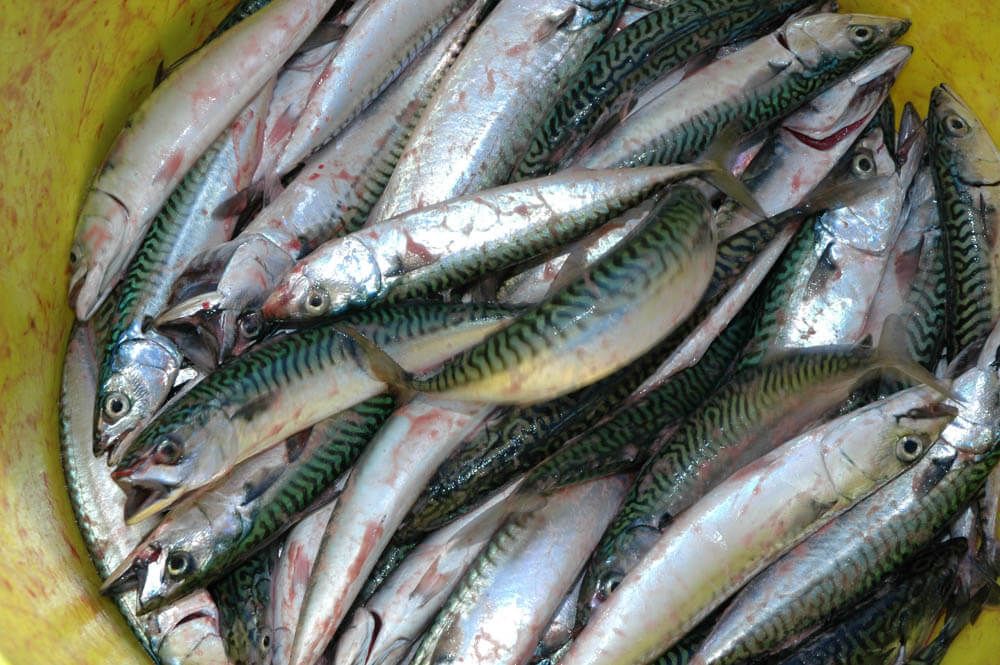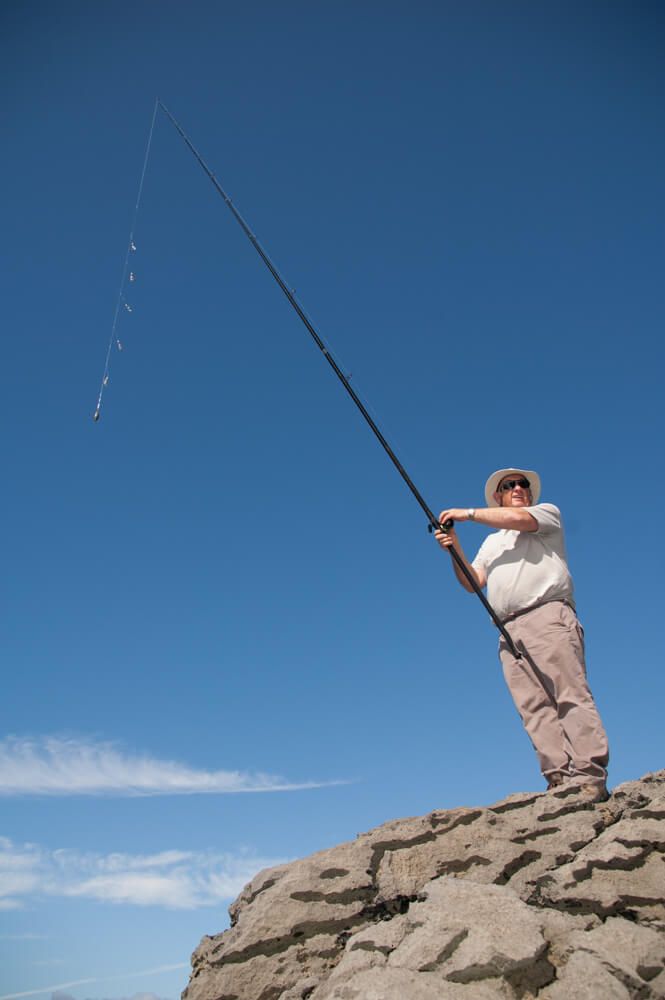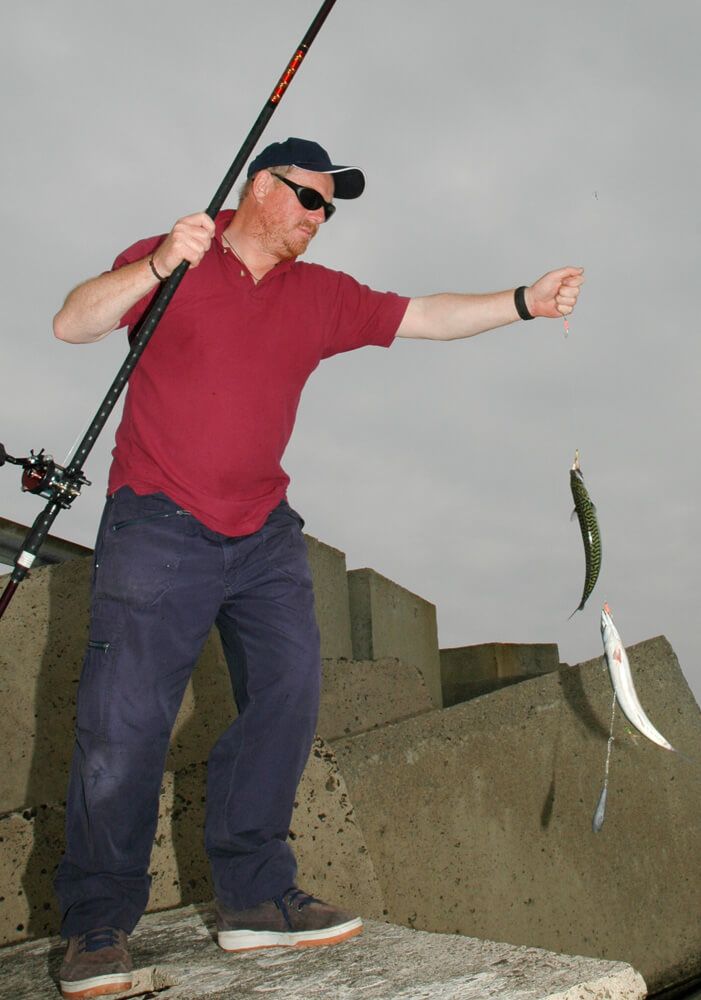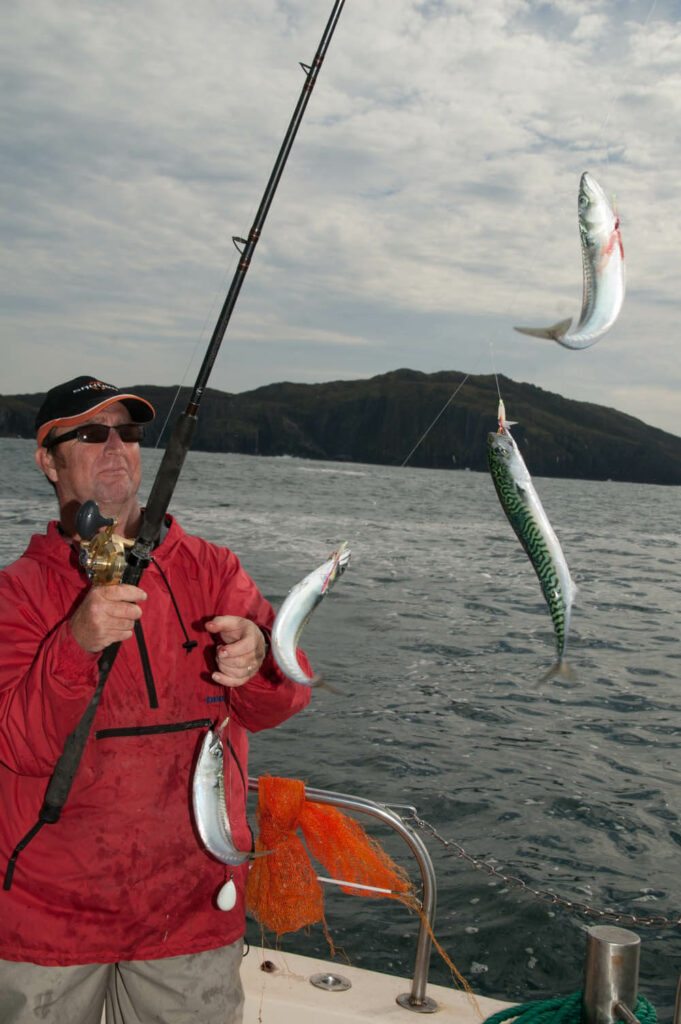With anglers in many parts of the UK struggling to find good, consistent catches of mackerel, Ian Nesbitt investigates why catches of this once prolific species have diminished in recent years.
For several years now catching mackerel from the shore in Southern Wales has become a decidedly hit and miss affair. Places that previously could be relied upon to provide good sport given the right tide are now fished in hope rather than in any expectancy. If it gets much worse the sight and smell of freshly caught mackerel sizzling on a smokey barbeque could become a dim and distant memory.
I’m sure that back in the Seventies it was different. The summer holiday was often spent on a farm in West Wales near Aberporth. Our Dad would lead my brother and I down string-thin paths where we’d be spiked and scratched by the thick stands of sulphur flowered gorse. Cuts were soon forgotten when we reached the rocky ledge from where spinners would be hurled to the horizon. Invariably the catch was mackerel; sometimes lots of mackerel, to the point when our slender arms would ache from the constant hauling. It was mackerel for breakfast and mackerel for tea. The resident farm tabby with tail pointing to the sky would appear from nowhere to rub our legs as we returned to the farmhouse. I’d never heard such loud purring.

Other years we would go to Devon and stay at Hope cove, an old fishing village sheltering in the lee of Bolt Tail. The best place for mackerel and garfish was off the rocky promontory of nearby Hopes nose. Here it was unusual not to find a long line of men, women and kids all enthusiastically fishing for their tea. The mackerel would come in pulses as the shoals swam in and out of the bay, and when they came they flung themselves suicidal at every gleaming piece of metal, feather and foil. We’d find a gap somewhere along the line, squeeze in, and start launching to the sky our Toby’s and feathers. Catching the fish was a foregone conclusion, success counted by the number of times you could heave in a ‘full house’ rather than any individual capture. Fish welfare was low on the agenda back then. Buckets and plastic bags would be full of flapping mackerel, the rocks slicked in slime and decorated with thousands of tiny glittering scales. Little rockpools would be pink with blood from the discarded severed heads and entrails; the salt air more like Billingsgate than Torquay. All this carnage yet the shoal would scarcely be dented. Year on year, any rocks, any beach with proximity to deep water the mackerel would teem, as reliable as the swallows of summer. In Clive Gammon’s book ‘A Tide of Fishes’ written back in the fifties he mentions a mackerel shoal spotted off the Pembrokeshire coast estimated at four miles long and a mile wide. They appeared inexhaustible.

More recently, in 2006, the mackerel shoals still appeared to be as healthy as ever. I hadn’t fished with my Dad for many years so when he visited my new home in South Wales it seemed a good idea to relive those boyhood days. We went to a rocky ledge on the Gower peninsula and cast our Toby spinners just as we had when ‘flares’ were wide and hair was long. No wind ruffled the sea that evening and our luck was in. The arrival of the mackerel was heralded by patches of boils and splashes on the smooth sea. Mackerel were on the hunt and tearing into balls of baitfish. The mackerel worked themselves into a frenzy, hurling themselves against rocks, pursuing their hapless victims’ right into the rock fissures, and gamely slashing at our flashing lures. Feathers made for rod bucking action. Strings of flapping mackerel came wheeling through the air; their vivid green backs iridescent in the evening sun, occasionally a twist of fate would see a lucky one flop back to the sea with a splash but most were destined for the grill. Spinners however, brought the bigger fish. The best must have been nudging two pounds and they fought like mini torpedoes, packing a punch well above their weight. My Dad beat me hands down for numbers of fish which at first I thought was down to luck but upon enquiry it turned out that despite us both using silver Toby’s, his was a heavier model; proof that there is more to spinning than thoughtless casting. The sun set the sea aglow over Carmarthen Bay as we hiked back along the cliffs carrying a heavy bag of fish. It was mackerel for tea and high spirits lightened the load. Back at home, the fish were gutted, the fresh green of their mottled backs now faded to the more familiar sea-blue of the fish found on the fishmonger’s slab. Ten minutes on the grill ‘till the skin crinkled black and the flesh fell from the bone and they’re done. Thick slices of bread and butter, a little salad, chilled white wine, and you have a meal fit for a King; my mouth-drools just at the thought. We had plenty left over to be soused in vinegar and baked in the oven the following day. It was reassuring that with so many fish of the sea in population freefall the mackerel was still plentiful, still a constant in the angling calendar; providing sport on the balmy days of summer just as they always had.

But since that day in 2006, at least in Wales, the mackerel have been far from reliable. The summer of 2007 was cold and no one was surprised when the mackerel were few. But since then their arrival has continued to be erratic; the numbers unpredictable. Every now and then a big shoal turns up, like off Cornwall last summer, but in Wales, once again, mackerel were hard to come by. Whilst fishing on a charter boat for tope a couple of years ago the skipper advised that we all bring along frozen mackerel as the real thing was proving elusive. He then quipped that the way things were going it was becoming harder to catch the bait than the tope. When the mackerel do turn up, the word soon gets around and city kids and seasoned salts are flinging their feathers, making hay while the sun briefly shines. But the action is all too often brief. So where have all the mackerel gone?
The mackerel is the single most important fish to the British fishing fleet worth around 500 million pounds to the British economy and employing some 2,000 people. The stocks of previous British staples, cod and herring are down, their prices up. The tasty flesh rich in life enhancing properties, along with eulogising by trendy TV chefs have made the mackerel popular as never before. Surely overfishing would be to blame again? This feeling was only enhanced when I discovered that fishing pressure had dramatically increased since 2008 roughly coinciding with my own perceptions of their fall. Following the collapse of their Blue Whiting stocks, Iceland and the Faroe Isles turned their attention to mackerel that were new arrivals to their waters. Catches by Iceland alone soared from 2,000 tons in the mid-2000’s to 130,000 tons in 2010. Now catches in this area constitute half of the total reported landings. Meanwhile the mackerel continue to extend their range northwards and Greenland is the latest country to join the mackerel party. Once Iceland and the Faroe Isles had started to fish, squabbles with Europe and Norway began over quotas. Thankfully these have been sorted out and quota’s that in theory are sustainable have been agreed.

In March 2014 ICES (International Council for the Exploration of the Seas) the body that advises governments on fishery policy, stated that the mackerel stocks of the north east Atlantic were at their highest level for over 25 years, with their figures showing a current spawning biomass of 4.5 million tonnes compared with 1.9 million tonnes in 2002. This was hardly what I expected. Perhaps survey methods are improved or perhaps the shoals are now more centred on the surveyed areas but an increase in population coinciding with a marked increase in fishing pressure is hard to square. Thankfully the latest advice is for a catch quota lower than expected, a welcome decision and one of hope to the conservationist.
Therefore it appeared that the mackerel stocks, though heavily but sustainably fished were still in a healthy state. Perhaps there was another reason for their apparent lack of numbers? There was.
The mackerel is a pelagic fish of a wandering nature. Studies and the previously mentioned catches have shown that the mackerel population of the north east Atlantic has been slowly moving northwards. The seas around our coast are warming at a rate of between 0.2-0.9 degrees centigrade per decade. As colder water has a greater nutrient capacity so it is the colder currents that the zooplankton will follow. These little creatures form a major part of the mackerel’s diet; herring and other small fish also. As the zooplankton move north the mackerel shoals follow. Also, a reduced number of zooplankton in their traditional ranges can lead to increased competition between the two species and they then forage further afield, thinning their respective populations over a wider area. So at the will of the ocean currents the vast aggregations of zooplankton are constantly moving and with them the mackerel. So as usual with problems of nature there is no straightforward answer. But one thing is for sure; next time the mackerel are in and I’m joining the hordes for hectic mackerel action, I for one will cherish the moment. No longer can they be taken for granted.
For several years now catching mackerel from the shore in Southern Wales has become a decidedly hit and miss affair. Places that previously could be relied upon to provide good sport given the right tide are now fished in hope rather than in any expectancy. If it gets much worse the sight and smell of freshly caught mackerel sizzling on a smokey barbeque could become a dim and distant memory.
I’m sure that back in the Seventies it was different. The summer holiday was often spent on a farm in West Wales near Aberporth. Our Dad would lead my brother and I down string-thin paths where we’d be spiked and scratched by the thick stands of sulphur flowered gorse. Cuts were soon forgotten when we reached the rocky ledge from where spinners would be hurled to the horizon. Invariably the catch was mackerel; sometimes lots of mackerel, to the point when our slender arms would ache from the constant hauling. It was mackerel for breakfast and mackerel for tea. The resident farm tabby with tail pointing to the sky would appear from nowhere to rub our legs as we returned to the farmhouse. I’d never heard such loud purring.

Other years we would go to Devon and stay at Hope cove, an old fishing village sheltering in the lee of Bolt Tail. The best place for mackerel and garfish was off the rocky promontory of nearby Hopes nose. Here it was unusual not to find a long line of men, women and kids all enthusiastically fishing for their tea. The mackerel would come in pulses as the shoals swam in and out of the bay, and when they came they flung themselves suicidal at every gleaming piece of metal, feather and foil. We’d find a gap somewhere along the line, squeeze in, and start launching to the sky our Toby’s and feathers. Catching the fish was a foregone conclusion, success counted by the number of times you could heave in a ‘full house’ rather than any individual capture. Fish welfare was low on the agenda back then. Buckets and plastic bags would be full of flapping mackerel, the rocks slicked in slime and decorated with thousands of tiny glittering scales. Little rockpools would be pink with blood from the discarded severed heads and entrails; the salt air more like Billingsgate than Torquay. All this carnage yet the shoal would scarcely be dented. Year on year, any rocks, any beach with proximity to deep water the mackerel would teem, as reliable as the swallows of summer. In Clive Gammon’s book ‘A Tide of Fishes’ written back in the fifties he mentions a mackerel shoal spotted off the Pembrokeshire coast estimated at four miles long and a mile wide. They appeared inexhaustible.

More recently, in 2006, the mackerel shoals still appeared to be as healthy as ever. I hadn’t fished with my Dad for many years so when he visited my new home in South Wales it seemed a good idea to relive those boyhood days. We went to a rocky ledge on the Gower peninsula and cast our Toby spinners just as we had when ‘flares’ were wide and hair was long. No wind ruffled the sea that evening and our luck was in. The arrival of the mackerel was heralded by patches of boils and splashes on the smooth sea. Mackerel were on the hunt and tearing into balls of baitfish. The mackerel worked themselves into a frenzy, hurling themselves against rocks, pursuing their hapless victims’ right into the rock fissures, and gamely slashing at our flashing lures. Feathers made for rod bucking action. Strings of flapping mackerel came wheeling through the air; their vivid green backs iridescent in the evening sun, occasionally a twist of fate would see a lucky one flop back to the sea with a splash but most were destined for the grill. Spinners however, brought the bigger fish. The best must have been nudging two pounds and they fought like mini torpedoes, packing a punch well above their weight. My Dad beat me hands down for numbers of fish which at first I thought was down to luck but upon enquiry it turned out that despite us both using silver Toby’s, his was a heavier model; proof that there is more to spinning than thoughtless casting. The sun set the sea aglow over Carmarthen Bay as we hiked back along the cliffs carrying a heavy bag of fish. It was mackerel for tea and high spirits lightened the load. Back at home, the fish were gutted, the fresh green of their mottled backs now faded to the more familiar sea-blue of the fish found on the fishmonger’s slab. Ten minutes on the grill ‘till the skin crinkled black and the flesh fell from the bone and they’re done. Thick slices of bread and butter, a little salad, chilled white wine, and you have a meal fit for a King; my mouth-drools just at the thought. We had plenty left over to be soused in vinegar and baked in the oven the following day. It was reassuring that with so many fish of the sea in population freefall the mackerel was still plentiful, still a constant in the angling calendar; providing sport on the balmy days of summer just as they always had.

But since that day in 2006, at least in Wales, the mackerel have been far from reliable. The summer of 2007 was cold and no one was surprised when the mackerel were few. But since then their arrival has continued to be erratic; the numbers unpredictable. Every now and then a big shoal turns up, like off Cornwall last summer, but in Wales, once again, mackerel were hard to come by. Whilst fishing on a charter boat for tope a couple of years ago the skipper advised that we all bring along frozen mackerel as the real thing was proving elusive. He then quipped that the way things were going it was becoming harder to catch the bait than the tope. When the mackerel do turn up, the word soon gets around and city kids and seasoned salts are flinging their feathers, making hay while the sun briefly shines. But the action is all too often brief. So where have all the mackerel gone?
The mackerel is the single most important fish to the British fishing fleet worth around 500 million pounds to the British economy and employing some 2,000 people. The stocks of previous British staples, cod and herring are down, their prices up. The tasty flesh rich in life enhancing properties, along with eulogising by trendy TV chefs have made the mackerel popular as never before. Surely overfishing would be to blame again? This feeling was only enhanced when I discovered that fishing pressure had dramatically increased since 2008 roughly coinciding with my own perceptions of their fall. Following the collapse of their Blue Whiting stocks, Iceland and the Faroe Isles turned their attention to mackerel that were new arrivals to their waters. Catches by Iceland alone soared from 2,000 tons in the mid-2000’s to 130,000 tons in 2010. Now catches in this area constitute half of the total reported landings. Meanwhile the mackerel continue to extend their range northwards and Greenland is the latest country to join the mackerel party. Once Iceland and the Faroe Isles had started to fish, squabbles with Europe and Norway began over quotas. Thankfully these have been sorted out and quota’s that in theory are sustainable have been agreed.

In March 2014 ICES (International Council for the Exploration of the Seas) the body that advises governments on fishery policy, stated that the mackerel stocks of the north east Atlantic were at their highest level for over 25 years, with their figures showing a current spawning biomass of 4.5 million tonnes compared with 1.9 million tonnes in 2002. This was hardly what I expected. Perhaps survey methods are improved or perhaps the shoals are now more centred on the surveyed areas but an increase in population coinciding with a marked increase in fishing pressure is hard to square. Thankfully the latest advice is for a catch quota lower than expected, a welcome decision and one of hope to the conservationist.
Therefore it appeared that the mackerel stocks, though heavily but sustainably fished were still in a healthy state. Perhaps there was another reason for their apparent lack of numbers? There was.
The mackerel is a pelagic fish of a wandering nature. Studies and the previously mentioned catches have shown that the mackerel population of the north east Atlantic has been slowly moving northwards. The seas around our coast are warming at a rate of between 0.2-0.9 degrees centigrade per decade. As colder water has a greater nutrient capacity so it is the colder currents that the zooplankton will follow. These little creatures form a major part of the mackerel’s diet; herring and other small fish also. As the zooplankton move north the mackerel shoals follow. Also, a reduced number of zooplankton in their traditional ranges can lead to increased competition between the two species and they then forage further afield, thinning their respective populations over a wider area. So at the will of the ocean currents the vast aggregations of zooplankton are constantly moving and with them the mackerel. So as usual with problems of nature there is no straightforward answer. But one thing is for sure; next time the mackerel are in and I’m joining the hordes for hectic mackerel action, I for one will cherish the moment. No longer can they be taken for granted.

